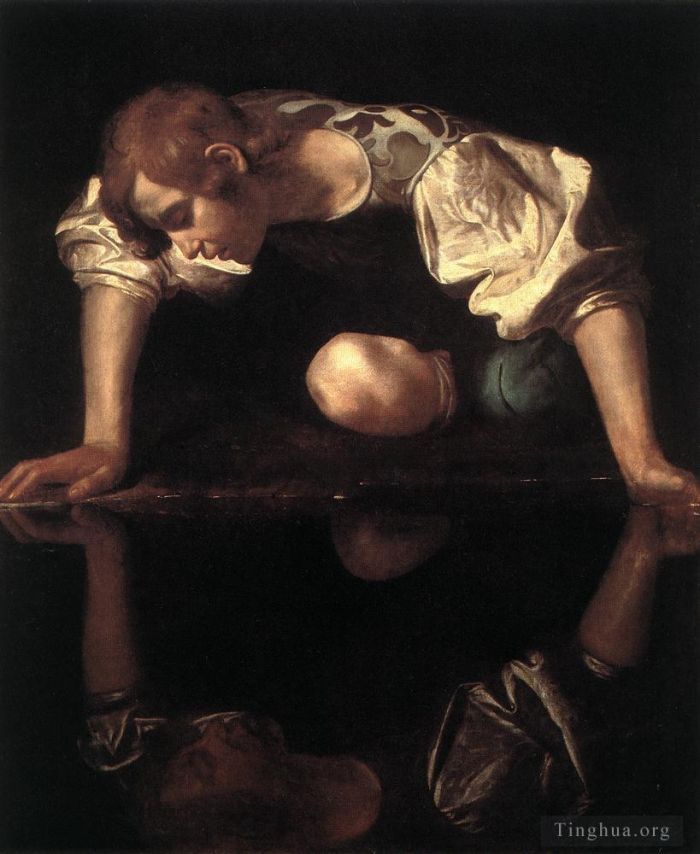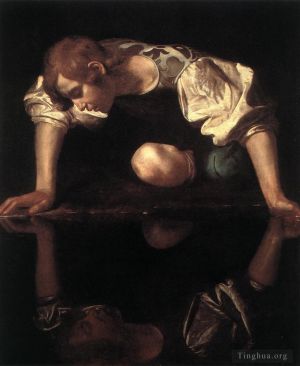Narcissus
Caravaggio
- Price: Price on Request
- Art Type: Oil Painting
- Size:
- English Comments: 0
- International Comments: 0
- Creating Date:
- Introduction and Works of Caravaggio >>
Keywords:
Narcissus
Work Overview
- Narcissus
Italian: Narciso
Artist Caravaggio
Year 1597–1599
Medium Oil on canvas
Dimensions 110 cm × 92 cm (43 in × 36 in)
Location Galleria Nazionale d'Arte Antica
Narcissus is a painting by the Italian Baroque master Caravaggio, painted circa 1597–1599. It is housed in the Galleria Nazionale d'Arte Antica in Rome.
The painting was originally attributed to Caravaggio by Roberto Longhi in 1916.[1] This is one of only two known Caravaggios on a theme from Classical mythology, although this is due more to the accidents of survival than the artist's oeuvre. Narcissus, according to told the poet Ovid in his Metamorphoses, is a handsome youth who falls in love with his own reflection. Unable to tear himself away, he dies of his passion, and even as he crosses the Styx continues to gaze at his reflection (Metamorphoses 3:339-510).[2]
The story of Narcissus was often referenced or retold in literature, for example, by Dante (Paradiso 3.18-19) and Petrarch (Canzoniere 45-46).[2] The story was well known in the circles of such collectors in which Caravaggio was moving in this period, such as those of Cardinal Francesco Maria del Monte and the banker Vincenzo Giustiniani. Caravaggio's friend, the poet Giambattista Marino, wrote a description of Narcissus.[2]
The story of Narcissus was particularly appealing to artists according to the Renaissance theorist Leon Battista Alberti: "the inventor of painting ... was Narcissus ... What is painting but the act of embracing by means of art the surface of the pool?"[3]
Caravaggio painted an adolescent page wearing an elegant brocade doublet, leaning with both hands over the water, as he gazes at this own distorted reflection.[2] The painting conveys an air of brooding melancholy: the figure of Narcissus is locked in a circle with his reflection, surrounded by darkness, so that the only reality is inside this self-regarding loop. The 16th century literary critic Tommaso Stigliani (it) explained the contemporary thinking that the myth of Narcissus "clearly demonstrates the unhappy end of those who love their things too much."
---------------
Caravaggio, the Italian Baroque master artist, created the painting Narcissus between the 1597 and 1599. It is one of two known paintings by Caravaggio with Classical mythological themes. This painting portrays the story of Narcissus, a handsome young boy, as told by Ovid, the poet. The story comes from Greco-Roman mythology and tells of the young boy falling in love with his own reflection.
Description
In this painting, Narcissus, who is surrounded by a dark and void background is fixated on his own reflection in a pool of water on the ground. Caravaggio’s earlier works almost always used a setting of a neutral and undefined space, as this depicts. Narcissus creates the boundary with his arm placement and appears to be locked in, forming a circle, possibly representing the dark and endless cycle of self-love. Caravaggio’s use of chiaroscuro, or contrasting, creates the illusion of three-dimensional forms. The water looks as if the viewer could fall in, with depth created by the use of shading and contrast. A dark and solemn mood is portrayed, but also an eerie beauty, which is characteristic of Caravaggio’s works.
The Mystery
It has been questioned by art scholars, whether the painting Narcissus was truly created by Caravaggio. Elements in the painting’s style and iconographic creativity has led to the acceptance that it was indeed one of Caravaggio’s creations. Caravaggio, a young and poor artist, was known to reuse models and costumes repeatedly, in order to save money. The facial features of Narcissus, look very similar to the angel in the painting Rest on the Flight into Egypt.
The composition of the vest that Narcissus is wearing, looks as if it is the same material as Mary’s dress in another of Caravaggio’s paintings, The Penitent Magdalene, as well. Caravaggio was also known to produce paintings with a suspenseful, magical and introspective atmosphere, during the middle of his career as an artist, which is very characteristic of this painting.
Narcissus in an oil on canvas painting, which is 110 x 92 cm in size, and of the Baroque art movement. It is displayed in Rome, Italy, at the Galleria Nazionale d’Arte Antica. It is an astute comparison between Narcissus and artists, in that artists have an inner Narcissus, because when they create art, they are looking to themselves in inspiration and creativity. This painting has a certain mystique about it, and is thought-provoking as well.
----------------------
Between 1597 and 1599, the Italian artist Michelangelo Merisi da Caravaggio composed an oil on canvas painting of a young man, staring deeply into a pool of water as he leans into it. What's going on? Is he trying to take a drink of water? No, he is falling in love with his own reflection. Caravaggio's painting of Narcissus depicts a tragic story from Greek mythology, set over a millennium later in the height of the Italian Renaissance.
Description and Meaning
Let's take a look at the painting itself. The scene is simple and minimalist. Out of a pitch-black background appears the figure of the youth, leaning over the dark waters in which his reflection can be seen. The boy is dressed in 16th-century style, fashioned as a pageboy.
What Caravaggio has captured is a scene from the Greek myth of Narcissus, the most famous version of the which was recorded by the Roman poet Ovid. In the myth, Narcissus is the most handsome youth in central Greece, but he never finds anyone attractive enough to love. Then, one day he passes by a pool of water and catches his own reflection. He falls in love with the reflection and tries to kiss it, but when his lips touch the water the ripples hide the reflection. Afraid of scaring away his newfound love, he sits and stares at the reflection until he dies of thirst.
Stylistic Analysis
The first step to appreciating Caravaggio's take on this story is to look at his style. Caravaggio was painting at the very end of the Italian Renaissance, but just before the emergence of the Baroque era in art. The Renaissance was an era obsessed with Classical perfection, and we see that in the highly realistic portrayal of this youth with his idealized features. At the same time, we see the early experiments with extreme shadow and dramatic, emotional presentation that would eventually characterize the Baroque. We call this late-Renaissance style Mannerism, and Caravaggio was one of its greatest masters.
Many artists represented the story in a manner similar to the painting on the left. In this comparison, we can see how dramatic and distinct the version by Caravaggio was One of Caravaggio's most important contributions to the era was the stylistic element of tenebrism, an extreme treatment of light and shadow. Caravaggio's Narcissus is an exemplary showcase of his tenebrism, the strong contrast between very dark and very bright spaces in a painting. Caravaggio uses this to entirely obscure the background. In this painting, there is nothing but Narcissus and his reflection, highlighting the obsessive focus of the youth. Everything else has faded from his attention.
---------------------
The attribution of this painting to Caravaggio has been discussed at length and it is still questioned by some scholars. There are no contemporary sources to refer to, and the attribution rests entirely on stylistic bases.
The theory that the picture is by Caravaggio might be confirmed by an export license dating to 1645, referring to a Narcissus by Caravaggio of similar measurements to our canvas. While it is difficult to propose with absolute certainty a secure connection between the document and the present canvas, several major Caravaggio scholars have reconsidered the issue, accepted the link between the license and the painting, and confirmed the autograph quality of the work.
Analysis of the details of execution (carried out as part of a recent restoration), stylistic comparison to other works of Caravaggio, and the iconographic innovativeness of the subject all lead to acceptance of the Narcissus as a work of Caravaggio. On the subject of invention, it suffices to mention the exceptional the double figure which - like a playing card - turns on the fulcrum of the highlit knee at the centre of the composition.
The work belongs to the years between 1597 and 1599, a transitional period of Caravaggio's career that is still not entirely sorted out or fully understood. It is a moment in which Caravaggio tended towards a magical sense of atmosphere, suspense, and introspection: still strongly influenced by the Lombard style of Moretto and Savoldo, he is also testing the infinite possibilities of light and shadow. Dating from the same phase of Caravaggio's career are the Lute Player, the Doria Magdalene, and above all the Thyssen St Catherine and Detroit Magdalene, with which our canvas has many connections and resonances.
- Copyright Statement:
All the reproduction of any forms about this work unauthorized by Singing Palette including images, texts and so on will be deemed to be violating the Copyright Laws.
To cite this webpage, please link back here.
- >> English Comments
- >> Chinese Comments
- >> French Comments
- >> German Comments
- >>Report
- Saint Jerome in Meditation
- Still Life with Flowers and Fruit
- The Musicians
- St John the Baptist Youth with Ram
- Supper at Emmaus
- Madonna and Child with St Anne
- Flagellation
- The Sacrifice of Isaac
- Young Sick Bacchus
- Nativity with St Francis and St Lawrence
- Portrait of Alof de Wignacourt1
- St John the Baptist
- The Sacrifice of Isaac2
- The Conversion of St Paul
- David with the Head of Goliath
- The Crucifixion of Saint Peter
- St John the Baptist1
- Narcissus
- Medusa
- Beheading of Saint John the Baptist
- The Martyrdom of St Matthew
- Boy with a Basket of Fruit
- The Denial of St Peter
- Salome with the Head of the Baptist
- Portrait of Alof de Wignacourt2
- St John the Baptist2
- St Francis1
- Saint Jerome Writing (Saint Jerome in His Study or simply Saint Jerome)
- Adoration of the Shepherds
- St Francis2
- Sleeping Cupid
- Saint Jerome Writing
- Christ in the Garden
- Jupiter Neptune and Pluto
- St John the Baptist at the Well
- Portrait of Maffeo Barberini
- The Crucifixion of St Andrew
- David with the head of Goliath
- Portrait of a Courtesan
- The Crowning with Thorns2
- Burial of St Lucy
- St Matthew and the Angel
- Boy Peeling a Fruit
- Ecce Homo
- The Seven Acts of Mercy
- The Entombment
- St Francis in Ecstasy
- The Inspiration of Saint Matthew
- Lute Player
- Judith Beheading Holofernes
- St John the Baptist
- The Incredulity of Saint Thomas
- The Fortune Teller
- The Tooth Drawer
- St Catherine of Alexandria
- Basket of Fruit still life
- David with the Head of Goliath
- The Crowning with Thorns
- Bacchus
- The Calling of Saint Matthew
- Boy Bitten by a Lizard
- The Raising of Lazarus
- Salome with the Head of St John the Baptist
- Magdalene
- The Conversion on the Way to Damascus
- Rest on Flight to Egypt
- The Fortune Teller
- The Lute Player
- The Annunciation
- Taking of Christ
- Amor Victorious
- Madonna di Loreto
- Christ at the Column
- The Death of the Virgin
- The Martyrdom of St Ursula
- Madonna del Rosario
- The Cardsharps
- Supper at Emmaus
- Martha and Mary Magdalene









 Singing Palette
Singing Palette